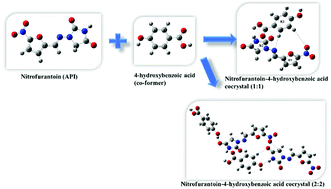Spectroscopic (FT-IR, FT-Raman, and 13C SS-NMR) and quantum chemical investigations to provide structural insights into nitrofurantoin–4-hydroxybenzoic acid cocrystals†
Abstract
Cocrystallization is an attractive approach to improving the physicochemical properties of active pharmaceutical ingredients (APIs), which have great potential in drug development. Accordingly, there is a growing need to understand the physicochemical changes that occur upon co-crystallisation. This work focuses on the combined use of spectroscopy and density functional theory (DFT) calculations to understand the molecular structure, hydrogen bond interactions and physicochemical properties of a pharmaceutical cocrystal. Solid-state NMR (ssNMR) spectroscopy can provide detailed molecular structure information on pharmaceutical cocrystals and complexes. It is non-destructive and usually provides deep structural insights that complement well with vibrational spectroscopy. In this work, a cocrystal of an antibiotic drug, nitrofurantoin (NF), with 4-hydroxybenzoic acid (4HBA) is examined to understand the capability of multiple spectroscopic techniques such as infrared (IR), Raman and solid-state NMR spectroscopies, and to confirm the molecular structure and hydrogen bonding of cocrystal systems. The results of IR and Raman spectroscopy showed that for the cocrystal formation, NF and 4HBA molecules interact through N–H⋯O–H interactions between the imide N–H of nitrofurantoin and the phenolic –OH of 4-hydroxybenzoic acid, and these interactions are also confirmed by natural bond orbital (NBO) and quantum theory of atoms in molecules (QTAIM) analyses. It is critical to understand whether a given cocrystal, upon conceiving a modified crystalline structure compared to that of its API, shows enhanced physical and chemical properties or not. Computationally, it is found that the NF–4HBA cocrystal shows softer (more reactive) behaviour in comparison to NF as its cocrystal, NF–4HBA, has a low band gap in comparison to the API, NF. These results demonstrate that the quantum chemical approach predicts accurately how to relate cocrystal with its physical and chemical properties.



 Please wait while we load your content...
Please wait while we load your content...